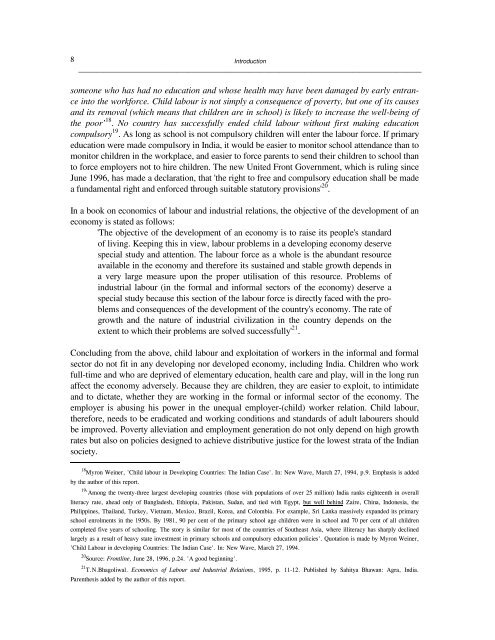You also want an ePaper? Increase the reach of your titles
YUMPU automatically turns print PDFs into web optimized ePapers that Google loves.
8 Introduction<br />
──────────────────────────────────────────────────────────────────────────────────────────────<br />
someone who has had no education <strong>and</strong> whose health may have been damaged by early entrance<br />
<strong>in</strong>to <strong>the</strong> workforce. <strong>Child</strong> <strong>labour</strong> is not simply a consequence <strong>of</strong> poverty, but one <strong>of</strong> its causes<br />
<strong>and</strong> its removal (which means that children are <strong>in</strong> school) is likely to <strong>in</strong>crease <strong>the</strong> well-be<strong>in</strong>g <strong>of</strong><br />
<strong>the</strong> poor’ 18 . No country has successfully ended child <strong>labour</strong> without first mak<strong>in</strong>g education<br />
compulsory 19 . As long as school is not compulsory children will enter <strong>the</strong> <strong>labour</strong> force. If primary<br />
education were made compulsory <strong>in</strong> <strong>India</strong>, it would be easier to monitor school attendance than to<br />
monitor children <strong>in</strong> <strong>the</strong> workplace, <strong>and</strong> easier to force parents to send <strong>the</strong>ir children to school than<br />
to force employers not to hire children. The new United Front Government, which is rul<strong>in</strong>g s<strong>in</strong>ce<br />
June 1996, has made a declaration, that '<strong>the</strong> right to free <strong>and</strong> compulsory education shall be made<br />
a fundamental right <strong>and</strong> enforced through suitable statutory provisions' 20 .<br />
In a book on economics <strong>of</strong> <strong>labour</strong> <strong>and</strong> <strong>in</strong>dustrial relations, <strong>the</strong> objective <strong>of</strong> <strong>the</strong> development <strong>of</strong> an<br />
economy is stated as follows:<br />
'The objective <strong>of</strong> <strong>the</strong> development <strong>of</strong> an economy is to raise its people's st<strong>and</strong>ard<br />
<strong>of</strong> liv<strong>in</strong>g. Keep<strong>in</strong>g this <strong>in</strong> view, <strong>labour</strong> problems <strong>in</strong> a develop<strong>in</strong>g economy deserve<br />
special study <strong>and</strong> attention. The <strong>labour</strong> force as a whole is <strong>the</strong> abundant resource<br />
available <strong>in</strong> <strong>the</strong> economy <strong>and</strong> <strong>the</strong>refore its susta<strong>in</strong>ed <strong>and</strong> stable growth depends <strong>in</strong><br />
a very large measure upon <strong>the</strong> proper utilisation <strong>of</strong> this resource. Problems <strong>of</strong><br />
<strong>in</strong>dustrial <strong>labour</strong> (<strong>in</strong> <strong>the</strong> formal <strong>and</strong> <strong>in</strong>formal sectors <strong>of</strong> <strong>the</strong> economy) deserve a<br />
special study because this section <strong>of</strong> <strong>the</strong> <strong>labour</strong> force is directly faced with <strong>the</strong> problems<br />
<strong>and</strong> consequences <strong>of</strong> <strong>the</strong> development <strong>of</strong> <strong>the</strong> country's economy. The rate <strong>of</strong><br />
growth <strong>and</strong> <strong>the</strong> nature <strong>of</strong> <strong>in</strong>dustrial civilization <strong>in</strong> <strong>the</strong> country depends on <strong>the</strong><br />
extent to which <strong>the</strong>ir problems are solved successfully' 21 .<br />
Conclud<strong>in</strong>g from <strong>the</strong> above, child <strong>labour</strong> <strong>and</strong> exploitation <strong>of</strong> workers <strong>in</strong> <strong>the</strong> <strong>in</strong>formal <strong>and</strong> formal<br />
sector do not fit <strong>in</strong> any develop<strong>in</strong>g nor developed economy, <strong>in</strong>clud<strong>in</strong>g <strong>India</strong>. <strong>Child</strong>ren who work<br />
full-time <strong>and</strong> who are deprived <strong>of</strong> elementary education, health care <strong>and</strong> play, will <strong>in</strong> <strong>the</strong> long run<br />
affect <strong>the</strong> economy adversely. Because <strong>the</strong>y are children, <strong>the</strong>y are easier to exploit, to <strong>in</strong>timidate<br />
<strong>and</strong> to dictate, whe<strong>the</strong>r <strong>the</strong>y are work<strong>in</strong>g <strong>in</strong> <strong>the</strong> formal or <strong>in</strong>formal sector <strong>of</strong> <strong>the</strong> economy. The<br />
employer is abus<strong>in</strong>g his power <strong>in</strong> <strong>the</strong> unequal employer-(child) worker relation. <strong>Child</strong> <strong>labour</strong>,<br />
<strong>the</strong>refore, needs to be eradicated <strong>and</strong> work<strong>in</strong>g conditions <strong>and</strong> st<strong>and</strong>ards <strong>of</strong> <strong>adult</strong> <strong>labour</strong>ers should<br />
be improved. Poverty alleviation <strong>and</strong> employment generation do not only depend on high growth<br />
rates but also on policies designed to achieve distributive justice for <strong>the</strong> lowest strata <strong>of</strong> <strong>the</strong> <strong>India</strong>n<br />
society.<br />
18 Myron We<strong>in</strong>er, '<strong>Child</strong> <strong>labour</strong> <strong>in</strong> Develop<strong>in</strong>g Countries: The <strong>India</strong>n Case'. In: New Wave, March 27, 1994, p.9. Emphasis is added<br />
by <strong>the</strong> author <strong>of</strong> this report.<br />
19 'Among <strong>the</strong> twenty-three largest develop<strong>in</strong>g countries (those with populations <strong>of</strong> over 25 million) <strong>India</strong> ranks eighteenth <strong>in</strong> overall<br />
literacy rate, ahead only <strong>of</strong> Bangladesh, Ethiopia, Pakistan, Sudan, <strong>and</strong> tied with Egypt, but well beh<strong>in</strong>d Zaire, Ch<strong>in</strong>a, Indonesia, <strong>the</strong><br />
Philipp<strong>in</strong>es, Thail<strong>and</strong>, Turkey, Vietnam, Mexico, Brazil, Korea, <strong>and</strong> Colombia. For example, Sri Lanka massively exp<strong>and</strong>ed its primary<br />
school enrolments <strong>in</strong> <strong>the</strong> 1950s. By 1981, 90 per cent <strong>of</strong> <strong>the</strong> primary school age children were <strong>in</strong> school <strong>and</strong> 70 per cent <strong>of</strong> all children<br />
completed five years <strong>of</strong> school<strong>in</strong>g. The story is similar for most <strong>of</strong> <strong>the</strong> countries <strong>of</strong> Sou<strong>the</strong>ast Asia, where illiteracy has sharply decl<strong>in</strong>ed<br />
largely as a result <strong>of</strong> heavy state <strong>in</strong>vestment <strong>in</strong> primary schools <strong>and</strong> compulsory education policies'. Quotation is made by Myron We<strong>in</strong>er,<br />
'<strong>Child</strong> Labour <strong>in</strong> develop<strong>in</strong>g Countries: The <strong>India</strong>n Case'. In: New Wave, March 27, 1994.<br />
20 Source: Frontl<strong>in</strong>e, June 28, 1996, p.24. 'A good beg<strong>in</strong>n<strong>in</strong>g'.<br />
21 T.N.Bhagoliwal. Economics <strong>of</strong> Labour <strong>and</strong> Industrial Relations, 1995, p. 11-12. Published by Sahitya Bhawan: Agra, <strong>India</strong>.<br />
Paren<strong>the</strong>sis added by <strong>the</strong> author <strong>of</strong> this report.


















